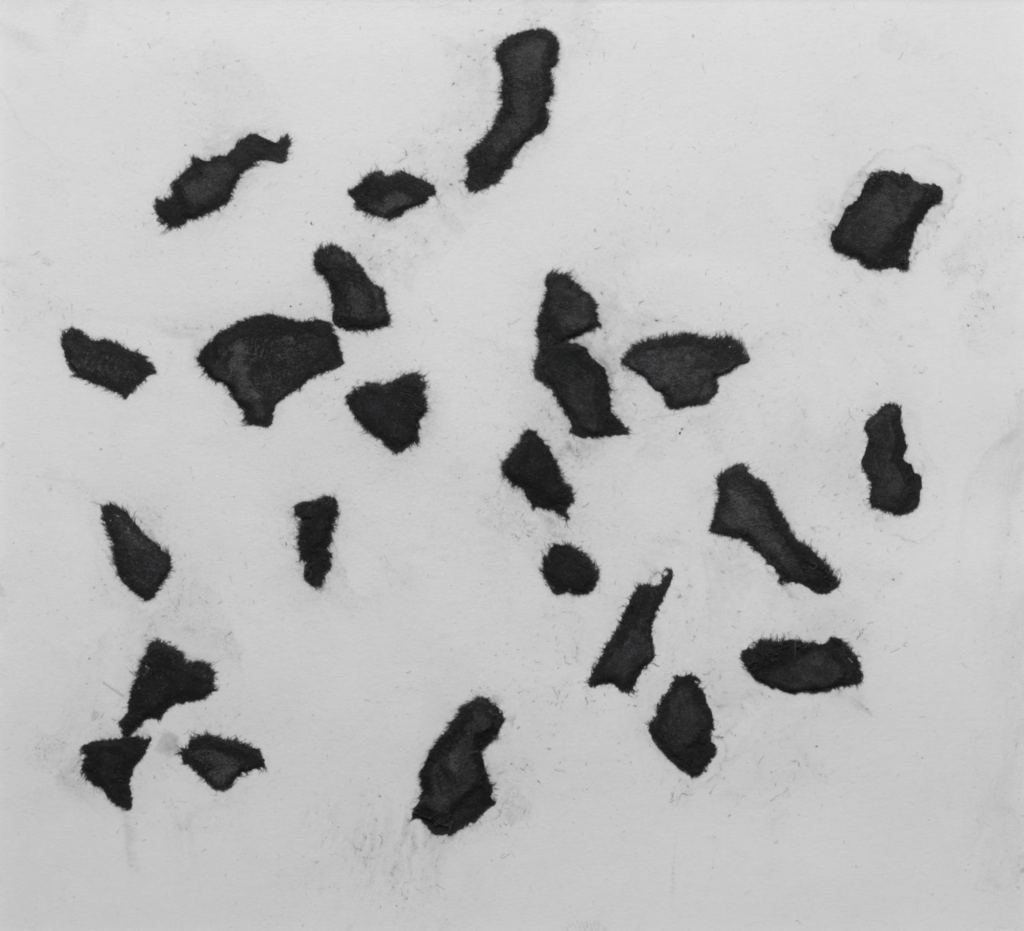Many artists base their work on randomness and spontaneity, which often makes the end result surprising and fresh, while the process itself is adventurous and inspiring for the artist. As a next step in my research, I explored some artists in whose work randomness appeared.
Jackson Pollock (1912-1956)
Abstract painting is abstract. It confronts you. There was a reviewer a while back who wrote that my pictures didn’t have any beginning or any end. He didn’t mean it as a compliment, but it was.
Jackson Pollock
Jackson Pollock, the renowned American artist, is closely associated with the concept of randomness in art. Using his self-developed „drip painting“ technique, he elevated the act of painting itself to the center of his artistic pursuits.1 By intentionally dripping and splashing paint onto the canvas, he forged unpredictable patterns that allowed for the unscripted manifestation of color and texture. It’s also worth noting that throughout his artistic process, his canvases were typically laid horizontally on the floor rather than upright on an easel. In addition, the tool he used, whether a brush or other tool, rarely made direct contact with the surface of the canvas.
However, anyone attempting to recreate a Pollock-esque composition soon realizes that the technique requires concentration, intention, and a technical understanding of how paint moves, splatters, and adheres to the canvas. It requires an understanding of the unique texture of paint and its response to gravity. Every flick of Pollock’s wrist as he applied paint to the canvas demonstrated precision. Despite the appearance of complete randomness, there was nothing arbitrary or accidental about each spill and splash.2

Number 5, 1948 by Jackson Pollock | Image source: jackson-pollock.org
Sol LeWitt (1928-2007)
LeWitt, a pioneer of minimalism and conceptual art, often employed random algorithms and guidelines in the creation of his artworks. He was a strong believer in minimalism, so much so that most of his famous works weren’t made by him. Instead of selling regular paintings on canvas, he sold „codes“ or procedures with clear instructions. A draftsman would follow these instructions, but his own skill and judgment were key in determining how the final artwork would look. This is exemplified in „Wall Drawing #85,“ where other artists followed a straightforward set of instructions that are open to personal interpretation, producing results that are consistently distinctive and unexpected. These instructions were: “A wall is divided into four horizontal parts. In the top row are four equal divisions, each with lines in a different direction. In the second row, six double combinations; in the third row, four triple combinations; in the bottom row, all four combinations superimposed.”3

Wall Drawing #85, 1971 first drawn by Sol LeWitt | Image source: https://massmoca.org/event/walldrawing85/
An other example is the “Wall Drawing #289”. Instructions: „A 6-inch (15 cm) grid covering each of the four black walls. White lines to points on the grids. Fourth wall: twenty-four lines from the center, twelve lines from the midpoint of each of the sides, twelve lines from each corner.“4

Wall Drawing #289, 1976, first drawn by Jo Watanabe | Image source:https://massmoca.org/event/walldrawing289/
Jean (Hans) Arp (1886–1966)
Artists of the Dada movement, such as Arp, turned away from the conventional and embraced randomness, chance, and spontaneity as essential elements of their art. Arp’s abstract forms reflect the randomness found in nature. Arp liked Taoist ideas about going with the flow and finding harmony in opposites. He felt that artists should be like messengers for nature, letting go of control and letting chance guide their creativity. This approach, he thought, provided a sense of liberation and artistic freedom.5 In his „Collage According to the Laws of Chance“, he dropped pieces of paper onto the canvas and glued them down where they landed, letting chance shape the work.6

According to the Laws of Chance,1933, Jean Arp | Image source: https://www.tate.org.uk/art/artworks/arp-according-to-the-laws-of-chance-t05005
- https://muvesz.ma/a-veletlen-szerepe-a-kreativ-folyamatban-a-muveszet-mint-inspiracio-es-spontaneitas/ ↩︎
- https://www.artdex.com/myth-genius-jackson-pollock/ ↩︎
- https://generativelandscapes.wordpress.com/2014/08/14/procedural-art-sol-lewitt-example-3-1/ ↩︎
- https://massmoca.org/event/walldrawing289/ ↩︎
- https://expressivemonkey.com/element-of-chance-2/ ↩︎
- https://www.tate.org.uk/art/artworks/arp-according-to-the-laws-of-chance-t05005 ↩︎


